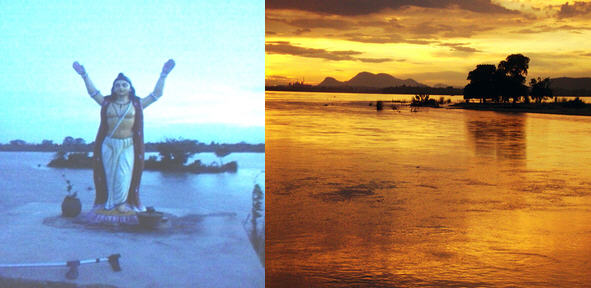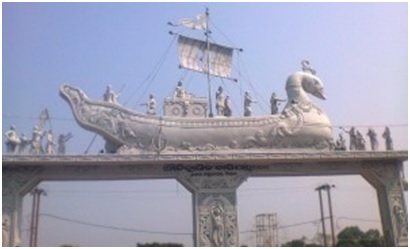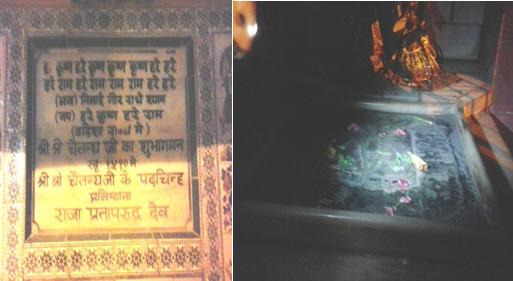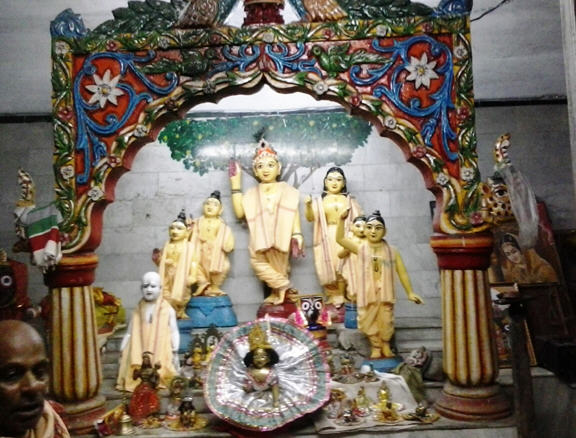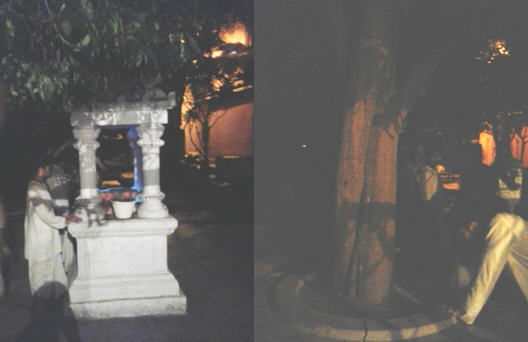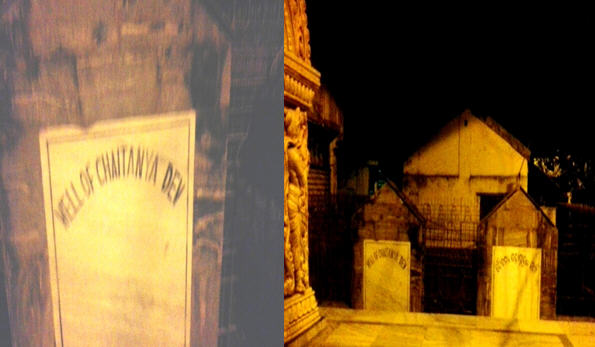On his way to Jagannath puri from Vrindavan ,Rupgoswami reached Orissa. In the province of Orissa there is a place known as Satyabhama-pura (in district of Kataka & is near the village known as Jankadei-pura).. Srila Rupa Gosvami rested for a night in that village on his way to Jagannatha Puri. While resting in Satyabhama-pura, he dreamed that a celestially beautiful woman came before him and very mercifully gave him the following order.“Write a separate drama about me,” she said. “By my mercy it will be extraordinarily beautiful.” After having that dream, Srila Rupa Gosvami considered, “It is the order of Satyabhama that I write a separate drama for her.I have brought together in one work all the pastimes performed by Lord Krsna in Vrndavana and in Dvaraka. Now I shall have to divide them into two dramas.” (Ref Chaitanya Charitamrita Antya Lila chapter
Deity of Sakshi Gopal in Kataka (Cuttack) – From the Anantavarman inscription of King Prataparudra deva, it is understood that his father Purshottam deva while marrying Padmini had defeated herfather the King of Karnataka, Nrsimha, and brought the Deity of Sakshi Gopala to Cuttack
The Saksi-gopala temple is situated between the Khurda Road railway station and the Jagannatha Puri station. The Deity is not presently situated in Kataka, but when Nityananda Prabhu traveled there, the Deity was present. Kataka is a town in Orissa situated on the Mahanadi River. When Saksi-gopala was brought from Vidyanagara in southern India, He stayed for some time at Kataka. Thereafter, He was situated for some time in the Jagannatha temple. It seems that in the temple of Jagannatha there was some disagreement between Jagannatha and Saksi-gopala, a disagreement called prema-kalaha, a quarrel of love. In order to settle this love quarrel, the King of Orissa constructed a village about eleven miles from Jagannatha Puri. The village was called Satyavadi, and Gopala was stationed there. Thereafter, a new temple was constructed. Now there is a Saksi-gopala station, and people go to Satyavadi to see the witness Gopala. (Chaitanya Charitamrita Madhyalila 5.10) Lord chaitanya Mahaprabhus visits to Cuttack.
From Chaitanya Bhagavat Antyakhanda chapter 2
TEXT 301
hena-mate mahanande sri-gaurasundara ailena kata dine kataka-nagara
In this way Sri Gaurasundara traveled in great ecstasy for a few days and then arrived at Cuttack. CB Antya-khanda 2.302
TEXT 302
bhagyavati-mahanadi jale kari' snana ailena prabhu saksi-gopalera sthana
After taking bath in the sacred Mahanadi River, the Lord went to the temple of Saksi-gopala. Cuttack is situated between the Mahanadi River and Katjudi and is the capitol of Orissa. A branch of Sri Caitanya Matha, named Sri Sac-cid-ananda Matha, has been established in this city. The Deity of Sri Gaurasundara and Sri Vinoda-ramana Jiu are regularly worshiped within the temple. From this temple various devotional scriptures and spiritual magazines are published in Oriya language. CB Antya-khanda 2.303
TEXT 303
dekhi' saksi-gopalera lavanya mohana ananda karena prabhu hunkara garjana
Upon seeing the sweet, enchanting form of Saksi-gopala, the Lord roared loudly in ecstasy. The Mahanadi River flows on the northern side of Cuttack. The Deity of Saksi-gopala was in Cuttack during the time of Sriman Mahaprabhu. This Deity was later transferred to a village named Saksi-gopala. After the disappearance of Sri Mahaprabhu this Deity of Saksi-gopala was first brought to the temple of Jagannatha and later installed in a separate village. This Deity has a large, four-armed form. The old story of Saksi-gopala is described in Sri Caitanya-caritamrta, Madhya-lila, Chapter Five. CB Antya-khanda 2.304
TEXT 304
`prabhu', bali' namaskara karena stavana adbhuta karena prema-ananda-krandana
The Lord cried out, “Prabhu!” and offered obeisances and prayers. He then began to cry wonderfully in ecstatic love. Saksi-gopala was previously situated in Cuttack on the bank of the Mahanadi River. When Saksi-gopala was first brought from South India, He stayed for some time in Cuttack and then stayed for some time in the Jagannatha temple in Purusottama. After some loving quarrel took place there, the King of Orissa established the village of Satyavadi six miles from Purusottama and kept Saksi-gopala there. At present Sri Saksi-gopala is being worshiped in a full-fledged temple. For a description of Saksi-gopala, one should read Sri Caitanya-caritamrta, Madhya-lila, Chapter Five. CB Antya-khanda 2.305
TEXT 305
yara mantre sakala murtite vaise prana sei prabhu—sri-krsna-caitanyacandra nama
Life is invoked in the Deity forms of the Supreme Lord by chanting His holy names. That Lord has now appeared as Sri Krsna Caitanya. The system of invoking life in the Deity form of the Supreme Lord by chanting the maha-mantra given by Sri Gaura is practiced in the Sri Gaudiya-sampradaya. Without chanting the Lord's holy names, the concept that the arca-vigraha is made of stone does not disappear. The rules and regulations for worship that Sri Krsna Caitanyadeva prescribed according to the concepts of the krsna-varnam tvisakrsnam verse consist of lively and proper worship of the Lord's Deity, based simply on chanting the maha-mantra. Wherever the Lord's service is performed without the physical involvement of the worshiper or wherever the worship is performed as a matter of formality, such worship and such deities are devoid of life. Chanting the Hare Krsna maha-mantra preached by Sri Gaurasundara is the topmost lively form of worship for a worshiper. CB Antya-khanda 2.306
TEXT 306
tathapiha niravadhi kare dasya-lila avatara haile haya ei mata khela
Yet in this incarnation the Lord always relished enacting pastimes as a servant. CB Antya-khanda 2.307
TEXT 307
tabe prabhu ailena sri-bhuvanesvara gupta-kasi-vasa yatha karena sankara
Thereafter the Lord went to Sri Bhuvanesvara, known also as Gupta-kasi, where Lord Sankara resides. Lord Chaitanya Visits Kataka from Chaitanya charitamrita – Chaitanya Charitamrita Madhya lila 5th chapter
TEXT 116
gopala rahila, dunhe karena sevana dekhite aila saba desera loka-jana
Lord Gopala stayed, and the two brahmanas engaged in His service. After hearing of the incident, many people from different countries began to come to see Gopala.
TEXT 117
se desera raja aila ascarya sunina parama santosa paila gopale dekhina Eventually the King of that country heard this wonderful story, and he also came to see Gopala and thus became very satisfied.
TEXT 118
mandira kariya raja seva calaila ‘saksi-gopala’ bali’ tanra nama khyati haila
The King constructed a nice temple, and regular service was executed. Gopala became very famous under the name of Saksi-gopala [the witness Gopala].
TEXT 119
ei mata vidyanagare saksi-gopala seva angikara kari’ achena cira-kala
Thus Saksi-gopala stayed in Vidyanagara and accepted service for a very long time.
PURPORT This city of Vidyanagara is situated in Trailanga-desa, South India, on the bank of the river Godavari. The place where the Godavari flows into the Bay of Bengal is called Kotadesa. The Orissa kingdom was very powerful, and Kotadesa was the capital of Orissa. It was then known as Vidyanagara. Formerly this city was situated on the southern side of the river Godavari. At that time King Purusottama-deva managed to control Orissa and appoint a government. The present city of Vidyanagara is on the southeast side of the river, only twenty to twenty-five miles from Rajahmundry. During the time of Maharaja Prataparudra, Sri Ramananda Raya was the governor there. Vijaya-nagara is not identical with Vidyanagara.
TEXT 120
utkalera raja purusottama-deva nama sei desa jini’ nila kariya sangrama
Later there was a fight, and this country was conquered by King Purusottama-deva of Orissa.
TEXT 121
sei raja jini’ nila tanra simhasana ‘manikya-simhasana’ nama aneka ratana
That King was victorious over the King of Vidyanagara, and he took possession of his throne, the Manikya-simhasana, which was bedecked with many jewels.
TEXT 122
purusottama-deva sei bada bhakta arya gopala-carane mage,—‘cala mora rajya’
King Purusottama-deva was a great devotee and was advanced in the civilization of the Aryans. He begged at the lotus feet of Gopala, “Please come to my kingdom.”
TEXT 123 tanra bhakti-vase gopala tanre ajna dila gopala la-iya sei katake aila
When the King begged Him to come to his kingdom, Gopala, who was already obliged for his devotional service, accepted his prayer. Thus the King took the Gopala Deity and went back to Kataka.
TEXT 124
jagannathe ani’ dila manikya-simhasana katake gopala-seva karila sthapana
After winning the Manikya throne, King Purusottama-deva took it to Jagannatha Puri and presented it to Lord Jagannatha. In the meantime, he also established regular worship of the Gopala Deity at Kataka.
TEXT 125
tanhara mahisi aila gopala-darsane bhakti kari’ bahu alankara kaila samarpane
When the Gopala Deity was installed at Kataka, the Queen of Purusottama-deva went to see Him and, with great devotion, presented various kinds of ornaments.
TEXT 126
tanhara nasate bahu-mulya mukta haya taha dite iccha haila, manete cintaya
The Queen had a very valuable pearl, which she wore on her nose, and she wished to give it to Gopala. She then began to think as follows.
TEXT 127
thakurera nasate yadi chidra thakita tabe ei dasi mukta nasaya paraita “If there were a hole in the Deity’s nose, I could transfer the pearl to Him.”
TEXT 128
eta cinti’ namaskari’ gela sva-bhavane ratri-sese gopala tanre kahena svapane
Considering this, the Queen offered her obeisances to Gopala and returned to her palace. That night she dreamed that Gopala appeared and began to speak to her as follows.
TEXT 129 “
balya-kale mata mora nasa chidra kari’ mukta paranachila bahu yatna kari’
“During My childhood My mother made a hole in My nose and with great endeavor set a pearl there.
TEXT 130
sei chidra adyapiha achaye nasate sei mukta paraha, yaha cahiyacha dite”
“That very hole is still there, and you can use it to set the pearl you desired to give Me.”
TEXT 131 svapne dekhi’ sei rani rajake kahila raja-saha mukta lana mandire aila
After dreaming this, the Queen explained it to her husband, the King. Both the King and the Queen then went to the temple with the pearl.
TEXT 132 paraila mukta nasaya chidra dekhina maha-mahotsava kaila anandita hana
Seeing the hole in the nose of the Deity, they set the pearl there and, being very pleased, held a great festival.
TEXT 133
sei haite gopalera katakete sthiti ei lagi ‘saksi-gopala’ nama haila khyati Since then, Gopala has been situated in the city of Kataka [Cuttak], and He has been known ever since as Saksi-gopala.
TEXT 134
nityananda-mukhe suni’ gopala-carita tusta haila mahaprabhu svabhakta-sahita
Thus Sri Caitanya Mahaprabhu heard the narration of Gopala’s activities. Both He and His personal devotees became very pleased.
TEXT 135
gopalera age yabe prabhura haya sthiti bhakta-gane dekhe—yena dunhe eka-murti
When Sri Caitanya Mahaprabhu was sitting before the Gopala Deity, all the devotees saw Him and the Deity as being of the same form.
TEXT 136
dunhe—eka varna, dunhe—prakanda-sarira dunhe—raktambara, dunhara svabhava—gambhira
They were of the same complexion, and both had gigantic bodies. Both wore saffron cloth, and both were very grave.
TEXT 137
maha-tejo-maya dunhe kamala-nayana dunhara bhavavesa, dunhe—candra-vadana
The devotees saw that both Lord Caitanya Mahaprabhu and Gopala were brilliantly effulgent and had eyes like lotuses. They were both absorbed in ecstasy, and both Their faces resembled full moons.
TEXT 138
dunha dekhi’ nityananda-prabhu maha-range tharathari kari’ hase bhakta-gana-sange
When Nityananda saw the Gopala Deity and Sri Caitanya Mahaprabhu in that way, He began to exchange remarks with the devotees, all of whom were smiling.
TEXT 139
ei-mata maha-range se ratri vanciya prabhate calila mangala-arati dekhina
Thus with great pleasure Lord Sri Caitanya Mahaprabhu passed that night in the temple. After seeing the mangala-arati ceremony in the morning, He started on His journey.
